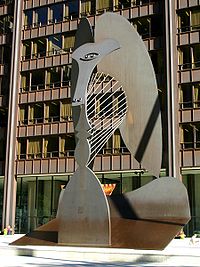Pablo Picasso
the 1930s, the minotaur replaced the harlequin as a motif which he used often in his work. His use of the minotaur came partly from his contact with the surrealists, who often used it as their symbol, and appears in Picasso's Guernica.[citation needed]Arguably Picasso's most famous work is his depiction of the German bombing of Guernica during the Spanish Civil War — Guernica. This large canvas embodies for many the inhumanity, brutality and hopelessness of war.[citation needed] Asked to explain its symbolism, Picasso said, "It isn't up to the painter to define the symbols. Otherwise it would be better if he wrote them out in so many words! The public who look at the picture must interpret the symbols as they understand them."[16]
Guernica hung in New York's Museum of Modern Art for many years. In 1981 Guernica was returned to Spain and exhibited at the Casуn del Buen Retiro. In 1992 the painting hung in Madrid's Reina Sofнa Museum when it opened.
Later works
Picasso was one of 250 sculptors who exhibited in the 3rd Sculpture International held at the Philadelphia Museum of Art in the summer of 1949. In the 1950s Picasso's style changed once again, as he took to producing reinterpretations of the art of the great masters. He made a series of works based on Velazquez's painting of Las Meninas. He also based paintings on works of art by Goya, Poussin, Manet, Courbet and Delacroix.

en./wiki/Image:2004-09-07_1800x2400_chicago_picasso.jpg
Picasso sculpture in Chicago.
He was commissioned to make a maquette for a huge 50 foot high public sculpture to be built in Chicago, known usually as the Chicago Picasso. He approached the project with a great deal of enthusiasm, designing a sculpture which was ambiguous and somewhat controversial. What the figure represents is not known; it could be a bird, a horse, a woman or a totally abstract shape. The sculpture, one of the most recognizable landmarks in downtown Chicago, was unveiled in 1967. Picasso refused to be paid $100,000 for it, donating it to the people of the city.
Picasso's final works were a mixture of styles, his means of expression in constant flux until the end of his life. Devoting his full energies to his work, Picasso became more daring, his works more colourful and expressive, and from 1968 through 1971 he produced a torrent of paintings and hundreds of copperplate etchings. At the time these works were dismissed by most as pornographic fantasies of an impotent old man or the slapdash works of an artist who was past his prime. One long time admirer, Douglas Cooper, called them "the incoherent scribblings of a frenetic old man".[citation needed] Only later, after Picasso's death, when the rest of the art world had moved on from abstract expressionism, did the critical community come to see that Picasso had already discovered neo-expressionism and was, as so often before, ahead of his time.
Legacy
At the time of his death many of his paintings were in his possession, as he had kept off the art market what he didn't need to sell. In addition, Picasso had a considerable collection of the work of other famous artists, some his contemporaries, such as Henri Matisse, with whom he had exchanged works. Since Picasso left no will, his death duties (estate tax) to the French state were paid in the form of his works and others from his collection. These works form the core of the immense and representative collection of the Musйe Picasso in Paris. In 2003, relatives of Picasso inaugurated a museum dedicated to him in his birthplace, Mбlaga, Spain, the Museo Picasso Mбlaga.
The Museu Picasso in Barcelona features many of Picasso's early works, created while he was living in Spain, including many rarely seen works which reveal Picasso's firm grounding in>
The film Surviving Picasso was made about Picasso in 1996, as seen through the eyes of Franзoise Gilot. Anthony Hopkins played Picasso in the movie.
Some paintings by Picasso rank among the most expensive paintings in the world.
"Nude on a black armchair" - sold for USD $45.1 million in 1999 to Les Wexner, who then donated it to the Wexner Center for the Arts.
Les Noces de Pierrette - sold for more than USD $51 million in 1999.
Garзon а la pipe- sold for USD $104 million at Sotheby's on May 4, 2004, establishing a new price record.
Dora Maar au Chat - sold for USD $95.2 million at Sotheby's on May 3, 2006.[17]
